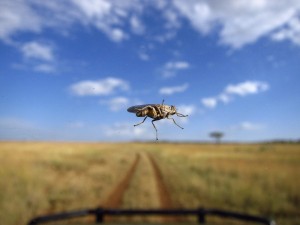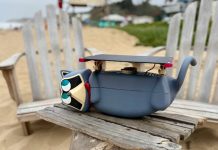NEWPORT BEACH (April 1, 2012) — Bad news for local developers and advocates of key Newport Beach projects: the dreaded Tsetse fly has been identified in the region and is no longer considered extinct in North America.
The Tsetse Fly first came to the West Coast on boats from Fiji and Bali carrying teak. The Tsetse fly would burrow into the wood, and stow away for the trip across the ocean. The native Indians feared and revered this flying menace. On one hand, the Tsetse fly had a nasty bite. Yet they were large enough to tie hemp around their abdomens so that they could be kept as pets.
Father Junipero Serra carried the Tsetse fly wherever he went. Father Serra set his California missions 13 miles apart as that is how far the average Tsetse fly could fly in a day. Father Serra used the fly in many of his preaching’s, as a sign of how resilient man and animals could be. Skeletons of the fly are often found up on the mesa, where native Indians would open seashells and prepare food.

So that brings us to an interesting question: Just what is a native species? By strict definition, the Tsetse fly is considered native. Although once thought extinct, this tiny creature could just become more important to coastal events than the gnatcatcher and coastal sage combined.
It appears that the latest version of the Tsetse fly does not bite, and burrows in soil and sand instead of soft wood. An inland group called “Save the Fire Rings” is trying to use this issue as a way to preserve the iconic treasures.
“We welcome back the Tsetse fly, and look forward to sharing a hot dog or s’more with you,” beams the group’s leader, C. Senior.
Corona del Mar resident Kitty Katz, from the group “Blow Out the Fires,” retorted by saying, “How do we know they did not bring the fly with them and plant them here?”
A local environmentalist, April Shauer, is optimistic as she encourages patience. “We expect lots of rain next month, so we have to wait until May to be sure,” she noted.
Shauer is concerned the El Nino season could wipe out local populations. Duane Pipe of “Heal the Harbor” is also concerned with the possible run off contamination from the Tsetse fly carcasses, but local nutritionist Anna Recksiek reports that Tsetse flies have been used as to add flavor and as a colorant for drinks.
As suspected, a local environmental activist is attempting to utilize the resurgence of this once-thought-extinct species as reason to halt development in the region.
Dr. I. Ball sees it this way: “We plan to thoroughly investigate to determine if the Tsetse fly is present, and if it was considered in the EIR process.”
On April 1, a group plans to visit the new City Hall with scientists to examine the site.
When I contacted several Councilmembers for comment, each said about the same thing: “If they come for the statue of Reagan, that fly will get swatted.”
However, one group recognizes the Tsetse fly as a way to help their cause. Those that want to see the 19th Street Bridge get built are now aware of the burrowing characteristics of the fly, and embrace it. Over time the winds have eroded soil in the area, and the construction efforts will break up the hard clay, restoring habitat.
When I contacted Costa Mesa and Huntington Beach for comments, they referred me to the OCTA, and to go to Helen Wait.
If residents have further questions, they can contact the City’s subject matter expert, Barb E. Dahl, at (949) 555-3001.
Green thoughts? JimFitzEco@gmail.com
Editor’s Note: April Fool! The Top 100 April Fools Hoaxes of All Time





My, My, My a little (or big) fly could be a “Fly in the Ointment” for all of those big old developers looking to destroy some of the LAST open land in Newport Beach.
Oh, this is just too good!.
Nice April Fool’s gag there, Jim.
I am sure this fly was in Hendersonville TN.I got bit by a few and it Left welts on me.I was wiped out exhausted for mo.nths, they look like bee’s and fly.like the picture.I am sure it was this fly.